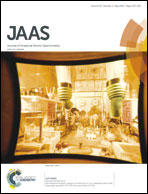Differencing as a method to estimate the uncertainty of a transient LA-ICPMS signal†
Abstract
Laser ablation inductively coupled plasma mass spectrometry (LA-ICPMS) usually yields transient time resolved signals, the (floating mean) intensity of which changes with time. Estimating the mean intensity uncertainty of a transient signal is useful methodologically and also helps computing the concentration (concentration ratio) uncertainty, provided the intensity ratio is defined as a ratio of the mean intensities calculated over the sweeps constituting the signal. This mean intensity ratio definition is more accurate for strongly fluctuating signals compared to the alternative (mean of ratios, intercept) definitions. Here we present a new method to estimate the mean intensity uncertainty of transient LA-ICPMS data based on the ratio-of-means model. It invokes calculating the intensity differences of each two successive sweeps in the original signal and statistically treating a series of these differences instead of the original signal. The transient trend is usually eliminated from the differenced data, allowing easy computation of the uncertainty of the mean difference and derivation of the mean intensity uncertainty for the original signal. By propagating the individual isotope mean intensity uncertainties, the isotope intensity ratio uncertainty can then be obtained.


 Please wait while we load your content...
Please wait while we load your content...